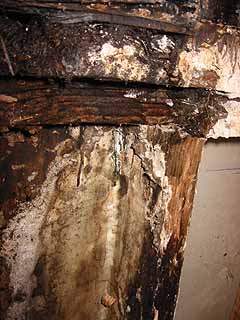|
Subscribe / Renew |
|
|
Contact Us |
|
| ► Subscribe to our Free Weekly Newsletter | |
| home | Welcome, sign in or click here to subscribe. | login |
Construction
| |
 |
August 12, 2004
Misunderstood fungus exacts a costly toll
KJM & Associates
The environmental health inspector told me he felt sick. I thought he was joking. Leaning against the foundation wall pointing his flashlight at aimless particles of crawl-space dust beneath the classroom he turned neon white. This was no joke.

Photo courtesy of the Northwest Wall and Ceiling Bureau
Not all molds are toxic. Those that are toxic require intense, prolonged exposure before they can cause sickness.
|
I learned something about his personal health condition. He learned that he must be more careful. Together we learned. So it is with the subject matter that caused both of us to be crawling around in the belly of a building.
Mold
Mold has been blamed for everything from blackouts to ovarian cysts and rupture. Even when medical reports will not support various health claims attributed to mold, the belief remains. What is it about this fungus that makes many intelligent people go berserk? Why has mold been so quickly equated with death?
There can be no humor where mold is concerned. Certainly misinformation.
3 attributes of mold
Mold has at least three attributes that we constantly praise in the construction industry. Mold is naturally occurring, it recycles and it is sustainable. Mold breaks down decaying organic matter into forms that can be reused by plant and animal life. Mold can live for thousands of years.
All mold needs to thrive is a food source and moisture. Dirt and dust are food sources. Moisture is contained in relative humidity and dew point. Throw in rain and it would seem that we will not escape this alleged predator.
Molds are ugly to most. All molds are not toxic. The poster child, Stachybotrys chartarum, is a wet, black, slimy toxic mold. To compare all molds to Stachbotrys is to compare all men to Darth Vader and all women to Medusa. Some molds just want to be. Some molds are good.
Exposure to mold
Enter mycologists. Mycologists are biologists who study mold and other fungi. All mycologists are not alike.
Enter medical mycology. Medical mycology is more than the study of mushrooms. Medical mycology deals with fungi and its microbial products which can cause disease. Diseases such as infection, allergy, asthma and at the very worst systemic body poisoning called mycotoxicosis.
Everyone reacts differently to mold depending on personal tolerance levels. Even when mold is present it will require exposure. Exposure can come from skin contact, inhalation or ingestion of the fungal material. Prolonged and intense exposure to even toxic mold is required. There are high-risk populations, specifically infants and the elderly.
Mold in the blood is an urban legend. According to state health officials, "After consulting with several physicians, including a state health officer and a physician epidemiologist, we can say with certainty that if mold cells (or bacterial cells) are visible in the blood of a patient using any microscope, that individual would be suffering from septicemia (blood poisoning) and would be extremely ill and at the point of death."
There are thousands of mold types and mold is everywhere.
Stoking fears
The emerging idea that mold is everywhere has raised awareness. Mold awareness is now taking as many forms as the mold itself. Not all forms of mold awareness have been positive.
It appears as if the past practice of marketing manipulation or as one client stated, "the profiting from our fears," has come to pass. We appear to be leaving the charlatan phase of mold remediation within schools.
When encountered there are very real costs associated with mold remediation.
Mold remediation costs vary with the scope of the verification, validation and actual prescriptive work that follows decisive investigation. The costs of achieving building environmental soundness are specific and measurable. The costs for emotional and political management are directly proportional to the rationality or irrationality of the participants.
Mold remediation project participants vary greatly. Many participants are supportive. Not all. Many projects involve the community. Some projects involve activists.
The hidden but very real personal agendas of various participants can be weighty. Achieving the participant consensus required for true success is likely the most difficult task involved with successful mold remediation.
Few standards
Participants' aside, mold remediation success is presently fraught with the potential for failure from the onset because of the lack of comparative standards within the environmental professional community. Suffice to say that even professionals have the potential to participate in "My Ph.D can take your Ph.D."
Complicating the lack of comparative environmental standards is the fact that dusts, cleaning supplies, pets, flowers, trees, perfumes and colognes can also cause many of the discomforting physical conditions associated with molds.
Like it or not, mold remediation projects are the result of something gone wrong. It may take more than just managing the water and controlling the moisture to rectify the problem.
For a cost, investigative analysis, prescriptive action, verification and validation can determine successful cost effective solutions supported by all.
It's refreshing to see that no-cost common sense appears to have returned to this issue in schools.
Clint Marsh is an educational program manager at KJM & Associates, a program and construction management firm.
Other Stories:
- Fast-track school projects require careful planning
- A little cooperation goes a long way
- Restoring order to the school-design process
- Stucco makes a comeback
- A second wind for historic schools
- New vocational center a model for innovation
- Architects are from Mars, educators are from Venus
- Alternative school-funding models pay off
- Achieve good design within budget
- Research fuels UW space needs
- Schools to experiment with sustainability


